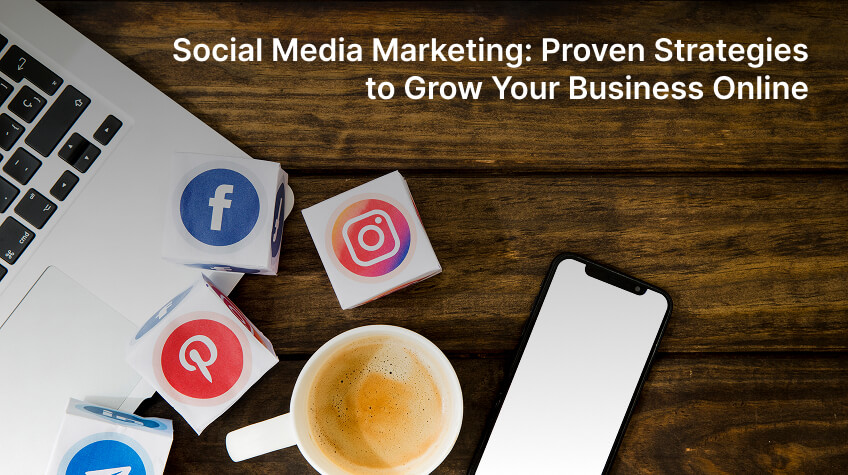
In today’s fast-paced digital world, social media marketing has become an essential and effective marketing tool. Over the years, it has transformed into one of the most powerful marketing platforms. Businesses of all sizes, from startups to renowned global brands make use of social media platforms to market their products, connect with customers, build awareness, drive sales and so on. The major reason for it is that the majority of people now use social media handles. Social media handles, like Instagram, Facebook, LinkedIn, X (formerly Twitter) and others have become an integral part of one’s life. So, if you are wondering how, you can grow your business online using social media marketing strategies, then read this post.
Here, we have outlined some of the proven social media marketing strategies that will help you grow your business online. So, without any further ado, let’s get started….
Before we move to the list of strategies, let’s first understand social media marketing. Here we go…
Table of Contents
Understanding Social Media Marketing

Social Media Marketing is one of the most popular and effective marketing strategies at the moment. It involves using social media platforms (like Instagram, Facebook, X, and so on) to promote and market products, services or brands. It includes creating engaging content, running paid ads, analysing audience behaviour, measuring campaign success and so on. Gone are the days when social media handles were optional and were used just for connecting and communicating with people.
They have become essential more than ever in this era of digital marketing. These platforms are not meant only for gaining followers, but are also meant to build rapport with the audience, foster trust, and drive meaningful actions
Why Social Media Marketing Matters
Social media marketing matters for several reasons, some of which are listed here. Take a look…
- Massive Brand Reach: With billions of users online, you have the freedom to reach out to them. This gives businesses access to a vast audience.
- Brand Awareness: Social media marketing allows you to create brand recognition with ease and consistently without putting much effort.
- Customer Engagement: Social media platforms are the best way to connect with your customers in real time and build credibility and community.
- Cost-Effective Marketing: Unlike traditional marketing which costs really high, social media platforms allow you to market your products or services at minimal budget and improve your ROI extensively.
- Data Analytics: It is easier than ever to get real-time data online using social platforms. These platforms provide powerful analytics that you can use to refine your marketing strategies and make well-informed decisions.
Let’s now take a look at the strategies that you can use to grow your business online. Here we go…
Top 15 Social Media Marketing Strategies To Grow Your Business Online
Here is our list of the proven social media marketing strategies that can help you grow your business online, reach your target audience effectively, and build a strong digital presence that converts. Take a look…
1. Setting Clear Goals and Objectives
Before you begin with your social media marketing, it is essential to define your social media goals. Having clear objectives from the beginning can help you avoid swerving from your marketing goals. Your goal could be to increase brand awareness, drive traffic to your website, generate sales or more leads, build an online community of 100,000 people, enhance customer experience and so on. Whatever your goal, setting SMART Goals is essential. SMART Goals, such as:
- Specific: Increase website traffic through Instagram or X posts.
- Measurable: Gain 10,000 followers within 3 months.
- Achievable: Based on your resources and budget.
- Relevant: Align with overall business objectives.
- Time-bound: Have a clear deadline to track progress.
Once you have set your goals, it’s the time to tailor your strategy to match different platforms and content formats.
2. Identify and Understand Your Target Audience

Knowing your audience is imperative before you begin to market your products. Knowing your audience in advance will help you choose the right social media platform. Here is how you can identify your audience:
- Analyse Existing Customers: Look at demographics (age, gender, location) and psychographics (interests, lifestyle).
- Use Platform Insights: Facebook Audience Insights, Instagram Analytics and LinkedIn demographics can help you with valuable data.
- Create Buyer Personas: Develop detailed profiles representing your ideal customers, their needs, goals and challenges.
- Study Competitors: Make sure to study your competitors to understand which all platforms they use and how their audience engages.
Once you know your audience, you can create content that not only appeals to their preferences and pain points, but also helps you improve engagement.
3. Choose the Right Platforms for Your Business
Different social media platforms cater to different types of audience. For instance, LinkedIn is primarily for professionals, while Facebook and Instagram are used by a large number of people and from all backgrounds. Choosing the right platform is crucial for achieving your marketing goals, as it depends on your industry, audience and goals. Here are the things that you should know about different social media handles:
- Facebook: Best for community building, ads, and brand storytelling.
- Instagram: Ideal for visual storytelling, product showcases and influencer collaborations.
- LinkedIn: Perfect for B2B marketing, professional networking and thought leadership.
- TikTok: Ideal for short-form videos and reaching Gen Z audiences.
- X (Twitter): Great for real-time updates, trends and brand voice.
- YouTube: Ideal for those who wish to create long-form video content and tutorials.
- Pinterest: Best for lifestyle, fashion, beauty and DIY content.
You can choose any of these platforms to promote your products or services depending on your niche or business type. However, it is often advised to avoid opting for too many platforms as it can hamper your efforts and consistency. Initially, you can opt for 2-3 platforms for the best outcomes. Also, maintaining 2-3 platforms won’t be troublesome.
4. Craft a Robust Content Strategy
Once you have finalized your social media handles, it’s time for crafting a robust content strategy. Without content (or we can say consistent content) you cannot ever benefit from these platforms. Also, it is essential to craft unique, valuable and relevant content to attract the right audience. So, for crafting attractive and engaging content, you should first know the different types of content used on social media platforms. Here is the list of different types of social media content for your reference:
- Entertainment Content: Memes, trends, relatable posts and reels.
- Educational Content: Tutorials, webinars, how-tos, infographics, industry insights and so on.
- Inspirational Content: Motivational quotes, success stories, and testimonials.
- Promotional Content: Product launches, discounts, offers and deals.
- Interactive Content: Polls, quizzes, webinars and live sessions.
Once you know the type of content you wish to create, it becomes easier to take the leap ahead.
5. Indulge in Content Planning

Only knowing the type of content you want to create is not enough. You need to plan your content according to the platform and your audience. So, what’s the rule?
Experts suggest to follow the 80/20 Rule
What’s that?
According to social media Gurus, you should keep 80% of your content informative or engaging, and 20% promotional. Doing so will help you build trust and prevent you from appearing overly sales-oriented. Here are some tips that you can follow; take a look…
- Creating a content calendar will help you maintain consistency.
- Maintain consistency throughout your content. This simply implies to use visual branding, such as consistent fonts, colors and tone.
- Make your content unique to catch your audience’s attention.
- Make it relatable, relevant, concise and crisp.
- Incorporate user-generated content (UGC) for authenticity.
- Repurpose top-performing posts across platforms.
6. Leverage Video Content

Whether you believe it or not, videos attract more people than the written content. Experts often suggest marketers to harness the power of video content. It dominates social media engagement. Content like Instagram Reels, YouTube Shorts and TikTok videos attract more audience than the ones published in written format.
If you have ever noticed, more and more businesses are now turning to video marketing. Do you know why?
Because, video content helps attract attention and keep users engaged for long. Aside from that, Google algorithms also prioritize video content. Furthermore, videos can communicate emotion and information more effectively and efficiently. So, which types of videos should you create? Here are some different types of videos to consider:
- Product demonstrations
- Customer testimonials
- Educational and informative tutorials
- Mini-tutorials
- Behind-the-scenes clips
- Q&A sessions or live streams
- Webinars and so on.
Make sure to choose the right type of video. The choice of video depends on the type of content you wish to communicate. Additionally, it is crucial to add captions and subtitles for users to watch videos on mute.
7. Engagement with Your Audience
Know that only creating extraordinary content is not just enough to survive cut-throat competition online. You will have to do a little more to stay at the top. So, what’s that?
Engage with your audience. Doing so will help you build long-term trust, loyalty and community. Here are some engagement strategies to implement; take a look…
- Respond promptly to comments and messages
- Encourage discussions by asking questions
- Host polls, quizzes, and giveaways
- Feature followers’ content (UGC)
- Use relatable and conversational captions
Interacting and engaging with users will help create brand recognition and build rapport with your audience.
8. Stay Consistent
Consistency is the key! You must have heard this many times and it goes really well with social media marketing. If you really want to succeed on online platforms, you have to be consistent no matter what! Consistency helps build trust, visibility, and brand recall. Posting sporadically or switching styles too often can confuse your followers. Here is what you can do to maintain consistency:
- Maintain a calendar
- Have a regular posting schedule
- Have consistency in your tone and style
- Maintain consistent visual identity
- Follow predictable engagement patterns (e.g., live every Friday)
- Use tools like Buffer, Hootsuite or Later to automate posting
- Make sure your brand remains active even during busy periods
9. Use Paid Advertising to Boost Reach

Undoubtedly, organic growth is valuable; however, spending on paid advertisement can help you achieve highest results. Almost every social media platform offers paid advertising options and ad tools that you can use to target audiences precisely. Here are some of the most popular ad options you have:
- Facebook & Instagram Ads: Ideal for improving traffic, sales and awareness campaigns
- LinkedIn Ads: LinkedIn Ads are great option for those looking for B2B lead generation
- YouTube Ads: Ideal for those wishing to improve storytelling and brand visibility
How to ensure the success of your social media ads?
Here are some tips you can use to ensure your ads bring you desired results; take a look…
- Budget properly
- Set a clear objective before launching campaigns
- A/B test different creatives and copy
- Target correctly
- Use retargeting to connect with interested users.
- Monitor analytics and optimize continuously
Using these tips, you can achieve your goals and reach your target audience with ease.
10. Track, Measure and Optimize Performance
Of course, choosing the right platform, crafting the right content, investing in paid advertising and strategizing your content will help you succeed in your goal. But there is more to it. What’s that? Tracking, measuring and optimizing performance. Yes, without tracking and measuring the performance, you won’t be able to achieve desired results. Hence, experts advise to track and measure the performance of your marketing across platforms to make data-driven results. Key metrics to monitor:
- Engagement Rate: Likes, shares, comments, saves
- Reach & Impressions: How many people saw your content
- Click-Through Rate (CTR): Effectiveness of your CTAs
- Follower Growth: Measure audience expansion over time
- Conversions & ROI: The ultimate measure of campaign success
Also, it is crucial to optimize your marketing. Here are some tips you can follow:
- Focus more on the content that deliver best results
- Adjust posting times based on engagement data
- Experiment with new formats (e.g., reels, short videos and so on)
- Stay updated with Google algorithm changes
- Engage with your audience
- Humanize your content
11. Stay Updated with New Social Media Trends
Understand that social media keeps changing. It evolves almost every day. What worked for you a few days back, may not work for you now. Hence, experts advise to stay updated with trends. Like today, authentic storytelling, AI-driven content creation and personalization are in trend. Aside from that, businesses are even using cutting-edge technology, such as AR and virtual try-ons for promoting their product and allowing their audience to have an immersive experience. Hence, you are advised to stay updated and open to change. Staying updated will help you have a competitive advantage and grow your business online.
12. Develop a Social Media Marketing Funnel
Like any marketing channel, social media marketing also needs a structured funnel. A social media marketing funnel can help you guide users from awareness to conversion. Here are the different stages of social media funnel:
- Awareness: Reach new users through posts, reels, and ads
- Engagement: Interact through comments, polls, and content value
- Conversion: Use CTAs leading to your website, store, or services
- Loyalty: Retain customers with rewards, exclusive offers, and personalized communication
Mapping this funnel will give you a structured view of your audience’s journey and help you engage the right users at the right time. Also, it will help you customize your content stage wise, so you can guide potential customers smoothly from awareness to decision.
13. Integrate Social Media with Other Marketing Channels
Integrating social media with other marketing channels is also crucial, in addition to following all the above-mentioned strategies. Know that social media works great when integrated with broader marketing strategies. Here is how you can do that; take a look…
- Add social share buttons to your website
- Share your blogs on LinkedIn and other social media handles
- Promote email newsletters via email and Instagram Stories
- Re-target website visitors using Facebook ads
Integrating social media with other marketing channels will help you achieve your marketing goals and maximize conversions.
14. Leverage Influencer Marketing
Influencer marketing is trending these days. More and more brands are now using influencers to promote their products or services online. So, if needed, you can also collaborate with influencers. But first, understand who social media influencers are.
Social media influencers are the individuals with credibility and loyal following. They are creators who influence opinions and purchasing decisions and can help you amplify your reach and brand trust. The best thing about influencer marketing is that you have the options to choose from different options.
Different Types of Influencers
- Nano Influencers: individuals or creators with under 10K followers
- Micro Influencers: individuals with 10K–100K followers
- Macro Influencers: creators with 100K–1M followers
- Mega Influencers: creators with over 1M followers
Don’t just collaborate with any influencer just like that. Instead, choose the one whose audience aligns with your brand values.
15. Optimize Your Content for SEO
Social media marketing and SEO go hand in hand. Without SEO, your social media marketing won’t help you fetch desired results. On the other hand, optimizing your profiles and posts enhances discoverability and helps you reach the right audience. Here are some tips to follow:
- Use relevant keywords in content, bios and captions
- Use keywords organically
- Make use of hashtags
- Add hashtags strategically
- Leverage YouTube and blog links to attract the right audience
- Optimize image alt-text for accessibility and SEO
If used correctly, together (social media and SEO) can increase your online footprint exponentially.
So, these are the proven strategies to grow your business online. Read ahead for some additional tips to elevate your marketing outcomes exponentially…
Additional Social Media Marketing Strategies
Here are some additional strategies to follow to grow your business online. Take a look…
1. Try Building an Online Community
Social media marketing is more than just gaining followers online. Today, businesses or personal brands focus on building a community rather than just gaining followers. Building a community will help you connect with your audience, build rapport and retain them for long to promote your business organically. You can build a community by engaging with your audience, responding genuinely to user feedback, creating personalized hashtags, hosting live Q/A sessions, highlighting customers’ stories or testimonials, and so on.
2. Partner with Other Brands or Creators
Collaborating with other brands or creators can help take your business to new levels. One of the best ways to cross-promote your brand is through guest posts, co-host webinars and Q/A sessions. There are numerous such ways you can promote your brand. Cross-promotion can help expand visibility, add credibility, foster engagement and so on.
3. Managing Reputation and Handling Negative Feedback
You cannot avoid criticism. Every business faces criticism online at some point. However, it isn’t a problem as long as you know how to respond. Yes, knowing how to respond to negative feedback or comments can be a game changer. Here are some things that you can do to handle negative feedback and manage reputation:
- Respond quickly and professionally
- Avoid reverting with reactive comments
- Never engage in arguments with your audience
- Take sensitive discussions to emails or DMs
- Don’t try to challenge your audiences’ understanding
- Acknowledge mistakes and offer solutions instantly
Following all these strategies can help you build rapport with your audience and maintain credibility.
So,these are the proven social media marketing strategies that can help you grow your business online. Remember, social media marketing is not just about posting images or running paid ads, there’s much more to it. The idea behind social media marketing is to create a narrative that connects with people on an emotional level. These strategies can help you drive growth, improve engagement, increase conversions, and build a thriving online community. By applying them, you can achieve results and gain a competitive advantage!






